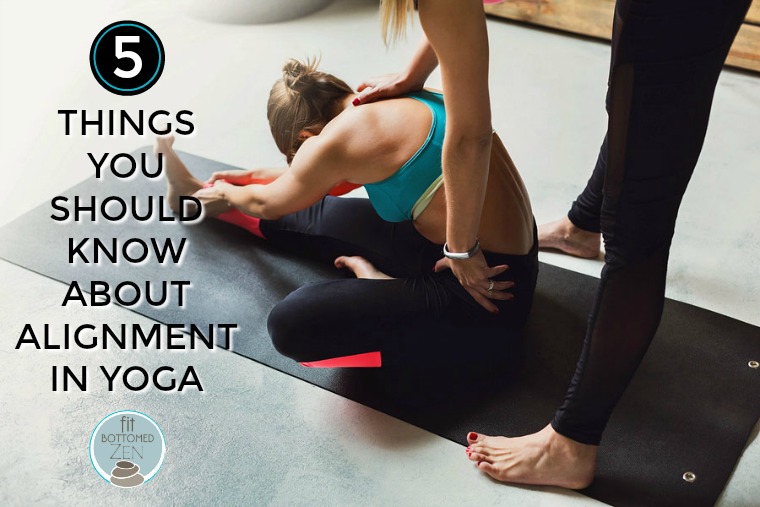5 Things You Should Know About Alignment in Yoga

Everywhere I look, I see conflicting information about pose alignment in yoga. It’s become a hot topic in the yoga world.
There’s no shortage of alignment cues — many are passed down through their respective lineages — but the only thing the Yoga Sutras tell us about the poses is that they should be steady and comfortable. With so many different cues out there and seemingly no agreement among the experts, what’s a Fit Bottomed Girl supposed to do?
Because of my background in human movement and corrective exercise, I naturally have some opinions. But it’s truly not my intention to turn this into an op-ed where I climb onto my yoga teacher soapbox and rant. Since it’s such a complicated subject, I’d prefer to just keep it simple.
With yoga injuries on the rise in the U.S., here are a few things you should know about alignment in yoga.
5 Things You Should Know About Alignment in Yoga
1. Align yourself, not the pose. Proper alignment is a highly individual — it’s not one-size-fits-all. Every person’s anatomy is unique, and each action in the human body occurs on a spectrum of extremes with every body falling somewhere in that spectrum. The alignment cues necessary to get a person into a pose in a way that’s anatomically correct for his or her body will vary widely. Your body was designed to move in a specific way. The idea is to find a physical position where you experience the benefits of the pose without risking injury.
2. Not every cue is about you. Teachers in group classes generally cue to the average of the people in the room (like those with tight, internally rotated shoulders or a loss of lumbar curve in their lower back) — and that may not include you. Unless the teacher is looking you directly in the eyeballs when she speaks, use each alignment cue as an opportunity to check in with yourself to see if you need to make an adjustment, but don’t immediately assume that every cue given in a class is directed at you.
3. Yoga is a practice of self-discovery. The goal isn’t to achieve every pose with perfect alignment and look like the yoga girls on Instagram, it’s to learn about yourself. The poses provide you with a chance to see your physical habits more clearly so that you can ultimately choose which habits serve you and which you might want to let go of in favor of a better way. Don’t become overly dependent on your yoga teacher’s cues — explore for yourself. You’ve been given this one body and it’s up to you and you alone to learn to listen to it and take care of it.
4. Yoga is spiritual; asana is physical. It’s a common belief that the poses have to be executed in a very specific and traditional way. But asana (the poses) is a physical activity and subject to the same rules of anatomy and physiology as other forms of human movement — at least if you want to enjoy your practice and limit your injuries. Think of it this way: The rules that apply to safe and functional movement in the gym also apply in yoga. Yoga teachers can get certified to teach yoga with a little as 10 classroom hours of anatomy. On the other hand, you’ve spent many years in your body so if it doesn’t feel right to you, don’t do it. Don’t ever let anyone pressure you into doing harm to yourself or doing more than you’re ready for at the time in the name of tradition.
5. Pain is not part of the process. Yoga can be uncomfortable sometimes. To be clear, I’m talking about a “wow, this is interesting and weird” kind of discomfort, not the “yikes this really doesn’t feel right and actually kinda hurts” kind of discomfort (aka pain). The practice is getting in tune enough with your body that you can discern the difference between discomfort and pain. While a stretching sensation in the belly of a muscle or covering wider areas are generally okay, don’t do anything that causes pinching or pain inside a joint or very close to one. This also applies to pain that develops after yoga class. Bottom line: If it feels bad, be compassionate to yourself, ease up and adjust.
If your yoga practice is hurting you, it’s time to make some changes. Look for a teacher with a background in human movement and hire her for a few private sessions so that you can safely explore your range of motion in each pose and investigate alternative ways to move your body.
Are you confused by all the alignment jargon out there? —Alison
